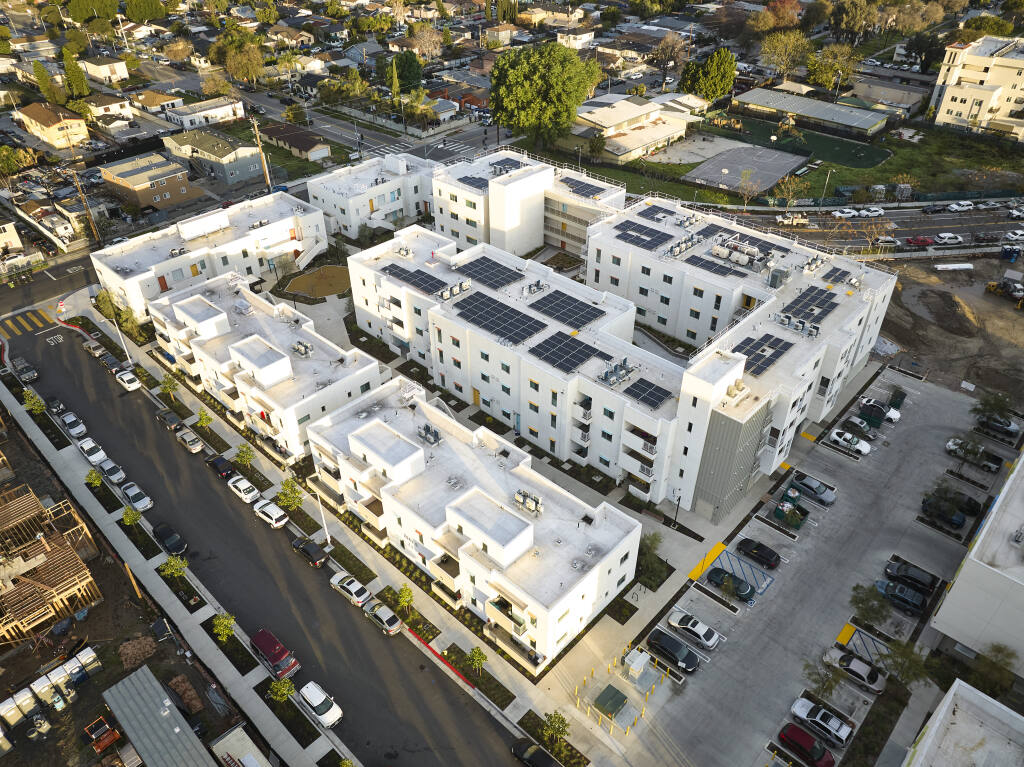Breaking Ground: John King, Chief Community Affairs Officer, Housing Authority of the City of Los Angeles

By Abram Mamet
9 min read
In 2007, the Housing Authority of the City of Los Angeles (HACLA) began exploring the possibility of a major redevelopment that would reshape Jordan Downs, one of the city’s most troubled areas.
Located in central L.A.’s Watts neighborhood, Jordan Downs was originally built in the 1940s to house workers during World War II. By 1955, HACLA had converted the 103 buildings across the site into 700 units of public housing. Over the ensuing decades, Jordan Downs served as a backdrop for many of the city’s most painful conflicts and a home for a tight-knit and enduring community.

By the mid-2000s, faced with Jordan Downs’ aging buildings and a need for more high-quality affordable housing, HACLA decided to embark on an ambitious mixed-income/mixed-use redevelopment that would double the number of units, create over nine acres of open space, including a 6.5 acre central park, with an approximate 95,000 square foot recreational center and bring over 115,000 square feet of retail into the community, including a much needed grocery store and other community serving retail. The redevelopment is 50 percent completed, with approximately 700 new units leased up.
Given the ambitious nature of the redevelopment, HACLA leaders realized one component had to be critical—it had to focus on the people who lived there. To ensure that residents’ voices remained at the center of the conversation, HACLA leadership selected John King, a longtime member of the organization, to lead the project’s community relations efforts.
With the first phase of the redevelopment complete, those efforts have borne fruit, as, according to King, over 85 percent of original residents have chosen to remain on site in the new units. “I can proudly walk through the community and go in and get hugs and talk to people,” he says.
Now serving as HACLA’s chief community affairs officer—a position he was promoted to in March 2025—King recently spoke to Tax Credit Advisor to share the many strategies he and his team have taken to build a culture of trust and clarity between HACLA and Jordan Downs residents.
This interview has been edited for length and clarity.
TCA: Tell us a bit about your journey into housing.
John King: I’ve been with HACLA for 28 years now. Before coming to HACLA, I worked for a couple of nonprofit organizations that worked with at-risk youth, both in the Seattle area and in Compton, Los Angeles. Growing up in Los Angeles, I had an affinity for working with and supporting young people and helping them achieve their goals by providing improved resources and opportunities.
My first position at the housing authority in the late 1990s was the youth programs coordinator. At that time, we had a resident relations department that provided a wide array of services and programs. My initial role was to provide youth programs on a large scale.
That work gave me an understanding of the landscape in our public housing communities and the various needs that our residents have. Also, when I first came to HACLA, I was a graduate student and decided to do my master’s thesis on the changing face of public housing. I focused on the large demographic shift in the Watts community from being a historically and predominantly African American community to one that is now a predominantly Latino community. That allowed me to understand better these shifts and their impact on the community, community leadership, and community engagement.
I had no idea that several years later I’d be working on this redevelopment effort and engaging the community, both Black and Brown, in a meaningful way, and where folks were allowed to be at the table in the planning stages.
TCA: How did you initially get involved with the Jordan Downs redevelopment?
JK: In 2007, our then CEO, Rudolf Montiel, asked me to make a map of the Jordan Downs site, outlining the boundaries of the public housing site, the adjacent factory, and the adjacent school.
This was still early in the conversations, but from a planning and policy perspective, I understood the housing authority’s vision and commitment to purchasing the 21-acre adjacent factory and redeveloping Jordan Downs comprehensively.
TCA: How specifically did you work to engage residents in those early years?
JK: One of the major milestones in the early days of the redevelopment came in 2008 when Congresswoman Maxine Waters conducted a congressional field hearing in the gymnasium at Jordan Downs. There were rumors that we were trying to purchase this adjacent land and start this redevelopment, so she hosted a panel to inform the community about what was happening.

It was a great way to open everything up and hear from the community. Meanwhile, we got the option to purchase the adjacent 21-acre parcel of land, and the Congresswoman said, “At any point if that happens, I want you to immediately establish a Jordan Downs Community Advisory Committee and let it be comprised of a cross section of residents, community stakeholders and other partners within the community. Let them be a part of creating the future. Ensure that they are at the table.”
That’s what we did, and by 2009, we had established the Jordan Downs Community Advisory Committee.
We then did a six-city tour, taking this cross-section of community members—school district representatives, youth, adults, local nonprofits, and LAPD representatives—to six cities across the country to see where public housing had been redeveloped and to talk to the folks who had been a part of it.
During those tours, we saw the commitment to resident services and investing in people, particularly in Atlanta. We recognize that this is very important for Watts: you can’t invest in property without investing in people.
As things progressed, the Community Advisory Committee was able to bring these ideas back. Although no one thought the redevelopment would take as long as it did, we retained that meaningful community engagement. Not just checking a box and having a meeting, but keeping our residents at the table.
For example, during the selection of a master planning firm, we trained a resident and allowed him to join the selection committee with city officials. That individual was also on the Community Advisory Committee so that he could report back to the committee. Once we got to the finalists, we brought the finalists out to the community to do presentations.
We received feedback from the community about those candidates, which helped inform our final decision, which was made by 2010.
TCA: Has that community engagement persisted, even though the planning process is complete?
We’ve continued that meaningful community engagement, with nearly half the project completed.
In addition to the Community Advisory Committee, we established a Community Coach Program comprising only on-site residents. It has had around nine to 14 individuals on an ongoing basis since 2010, and they are our main support for outreach and engagement. They’re the most informed residents at the site. We sit down and answer questions for hours. “Are we going to be displaced? If we’re displaced, do we get to come back? How in the world can I keep paying $500 a month for rent if you give me this brand-new unit?”
Early on, I learned that it’s not just about explaining it; it’s about them trusting you over time, understanding the knowledge, and getting it into their spirits. People kept coming back to me, asking more and more questions, and because we had that rapport and relationship, we were able to take it to that next level of education and explanation.
TCA: Any particularly successful techniques within your outreach programs?
JK: Establishing trust and rapport with the community coaches. They did all the outreach for us with our community meetings, door knocking, and answering questions.
Over time, we learned not to simply say to pass out flyers. I’d have each of them go out with a sign-up sheet and have them sign up 20 people. At the meetings, I’d have our coaches at the door, checking people in so that there was more accountability in the outreach.
It’s not just about flyers; it’s about having a conversation.
We also equipped them with information on such a deep level that they had answers when they had those conversations. We did that by bringing those community coaches to the main office for public board meetings. Anytime Jordan Downs was on the agenda, we’d bring the coaches. And what happened is that they’d be hearing consistency. They’d have these community meetings and speak about these things, and then they’d hear the commissioners present about the same things.
When they return to the communities, they can bring information directly from the board meetings. This really arms our coaches with knowledge and takes the power away from rumors and people without knowledge or information.
We’re creating an atmosphere of unity.
TCA: How does your long history within the organization inform your work on the leadership side, where you currently serve as the organization’s chief community affairs officer?
JK: It is an understanding of the needs and concerns of the residents and how these policies impact the community. One of the things I’ve always appreciated about being on the senior staff is the level of confidence I have in speaking with the community. In meetings with the CEO and Mayor’s office, I speak firsthand to residents, as opposed to if someone just gives me a script or briefs me on a meeting I wasn’t in.
I’ve been able to relay residents’ concerns to those leadership meetings and help shape our path forward in terms of engagement and information sharing. I operate with this whole idea of trauma-informed community engagement—understanding the background and needs of the community and making appropriate adjustments so that we have an effective process.
Having this balance between years of working in the community before diving into policies and understanding their impact on the residents has been helpful. One of the things that I try to pride myself on is relaying the information in a way that people can digest.


